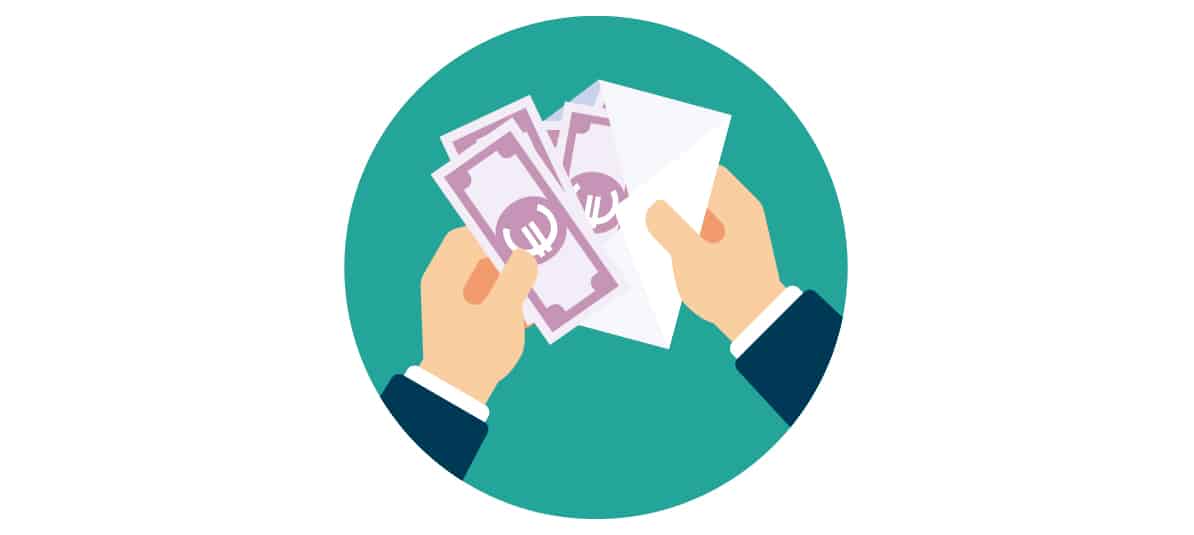It should help you make sure that you spend what you want and on what you want. Also, if you are well organized, you will even be able to save every month.
What is the savings envelope method?
This method is very simple. It consists of dividing your income into different expense categories, just like with a budget, and setting up an envelope for each of them.
Once you have received your wages, all you have to do is put the assigned amount in each envelope and use it as needed. It’s that simple.
For example, if we have a supermarket envelope, every time we go shopping we pick up that envelope and use the money in it until it runs out. And so on with each of the envelopes we have set up.
In fact, this method does not include a specific number of envelopes. That depends on your savings goals and how you want to divide your expenses.
Advantages of the envelope method
Thanks to this saving method:
- You make sure you spend what you want in each area (the money in the envelope). This makes it very useful for hard-to-control expenses such as leisure and entertainment, or a budgeted area where you tend to spend more than you want to, such as grocery shopping.
- You clearly see the evolution of each expense. As the month progresses you will see how the money in the envelope decreases. This will give you an accurate picture of both what you are spending and what you can spend. For example, it is common for the money in the shopping envelope to go down a lot at the beginning of the month. This may be a sign that your shopping patterns are different on those days, either because you buy different things or because you focus your shopping on those days. The envelopes allow you to see clearly how much you have spent and how much you have left, so you can make decisions about it.
- It forces you to budget. One of the keys to the process is to think about how much money you will put into each envelope. Doing this will force you to budget and think about how much and what exactly you want to spend your money on. For that reason alone, it is worthwhile doing.
- It helps you save and detects (non-monthly) recurring expenses. When you have to think about your expenses and income, it makes sense to think about your savings and set aside an envelope for saving each month. Also, the envelope method can be used for any type of expense, not just monthly ones. Once you start thinking about how to allocate your money and which expenses you need to cover, it is typical for you to start thinking about things like insurance and even vacations, which are annual expenses that you can save for month by month in one of your envelopes.
- It gives you a huge sense of control over your finances, as you know where each of your euros is going and how much you are spending at any given time.
This savings formula also has its limits and drawbacks. You’ve probably already noticed the first one: it involves quite a bit of work.
It is a strategy that will force you to keep a close eye on your finances and make a budget.
In addition, if you set up too many envelopes, the system can become unmanageable.
How to set it up one step at a time
Starting to save with the envelope method is quite simple. Here are the steps you should follow:
Step 1. What is your income?
As with budgeting, the first step is to know how much money you have so you can spread it out over the month.
Step 2. What are your expenses and how do you want to distribute your money?
This is the most time-consuming step, but it is also the most important one. The essence of this method involves creating budget categories.
To do this you can start by reviewing your fixed recurring expenses, those that will definitely have their own envelope. This way you will have a rough idea of how you spend your money and you will be able to think about the changes you want to make.
It will also allow you to detect expenses you didn’t know you had and others you hadn’t budgeted for, such as your vacations.
Armed with that data, it is time to create your own categories and formula for distributing your money. If you still have doubts about how to do it, you can start with simple strategies that have been working for years, such as the 20-30-50 method, also known as The Balanced Money Formula. This strategy allows spending 50% on necessities, 30% on whims or leisure, and 20% on savings and investment.
Each of the envelopes you use should be based on this.
Another option is the six money accounts of Harv Ecker, author of “The Secrets of a Millionaire Mind” and who actually proposes an adaptation of the envelope method. This is how you distribute your expenses.
Step 3. Set up the envelope system
Once you know the numbers, all you have to do is buy as many envelopes as you need.
If keeping cash in envelopes seems like a thing of the past, there are several ways to adapt the envelope tool to the present day.
On the one hand, some banks already let you use piggy banks or subaccounts, which are effectively “envelopes” for your different savings objectives.
Alternatively, you could use prepaid cards for the areas where you spend money on a monthly basis. For example, a prepaid card for leisure, another for the supermarket, etc. For annual expenses like vacations, an envelope or a bank subaccount usually works best.
Step 4. Spend and monitor
Finally, you just have to start it all up. In other words, start living your life and spending as you normally would, but using the money in those envelopes.
With this system you will be able to track and see clearly how much money you have left in each area and adapt your expenses and plans to it. For example, if there is not much money in the leisure and entertainment envelope, you know that you will have to look for cheaper options, just as if the supermarket envelope gets low on funds, you will have to look for less expensive alternative menus.
Ultimately, this method works for people who have so far not been able to control their spending and are now looking for a way to do so. For these kinds of people, the envelope method can be very useful.
It will also help you if you are looking to limit spending in a specific area of your finances.









